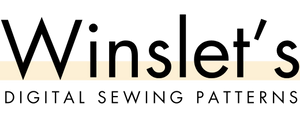Seam Allowances on Our Digital Patterns
At Winslet’s, all of our digital patterns are provided in layered files, with seam allowances on separate layers for each size. This setup makes it easier to adjust for your preferred fit and ensures precision when cutting and sewing.
We suggest using the pattern as provided, with the assigned seam allowances, to achieve the most accurate results. These seam allowances are designed to work seamlessly with each piece, so you can focus on bringing your garment to life without worry.
For a step-by-step guide on how to navigate our layered files and use the seam allowances correctly, please refer to the following video tutorial:
Customizing Seam Allowances
1. If you prefer to cut directly on the seam allowance rather than tracing the pattern’s stitch lines, you can use the seam allowance mentioned in the sewing guide when sewing.
For woven garments, seam allowances are typically wider at the hem to accommodate finishing.
Pro: This method allows for faster cutting and sewing without the need for additional markings.
Con: If the fabric is not handled meticulously, it can stretch or distort, leading to inaccurate stitching that doesn’t follow the intended pattern lines.
2. If you choose to trace the pattern stitch lines, you have the option to adjust the seam allowance as you prefer. As long as the traced stitch lines remain true to the given size, you can increase or decrease the seam allowance depending on your fabric or sewing needs.
Pro: You can further tailor your project to your specific sewing style, while still maintaining the intended fit and structure of the pattern.
Con: It takes a bit more time and effort, as you’ll need to trace all the pattern markings and stitch lines before adjusting the seam allowance.

